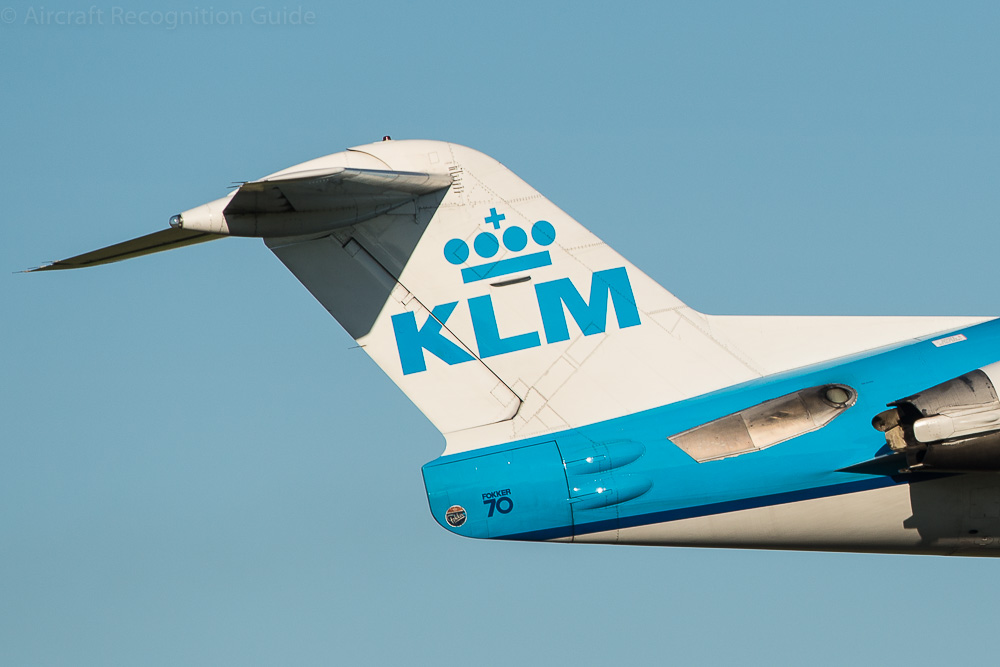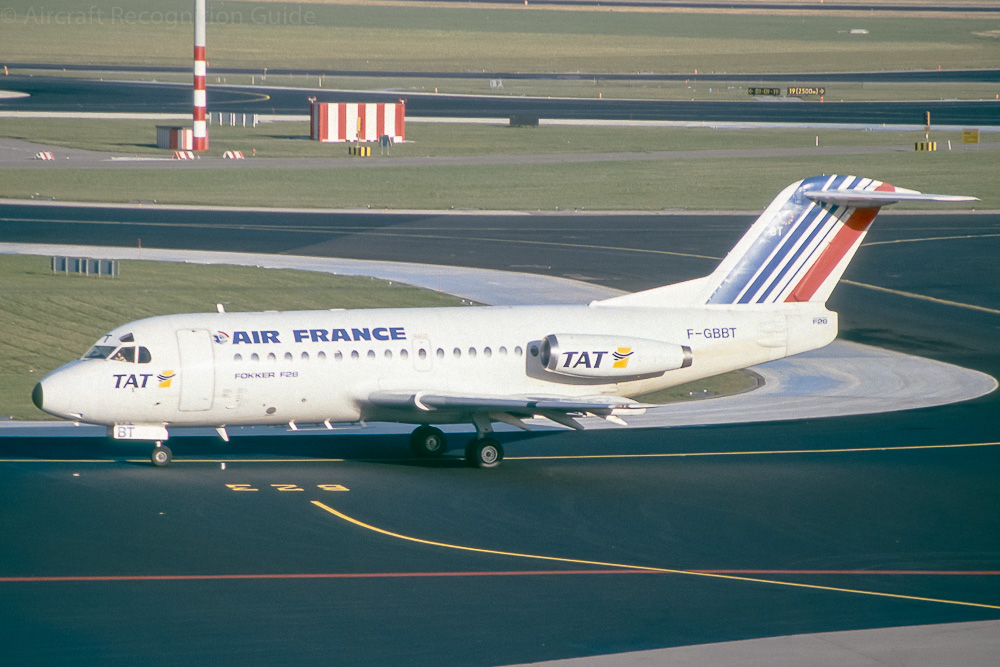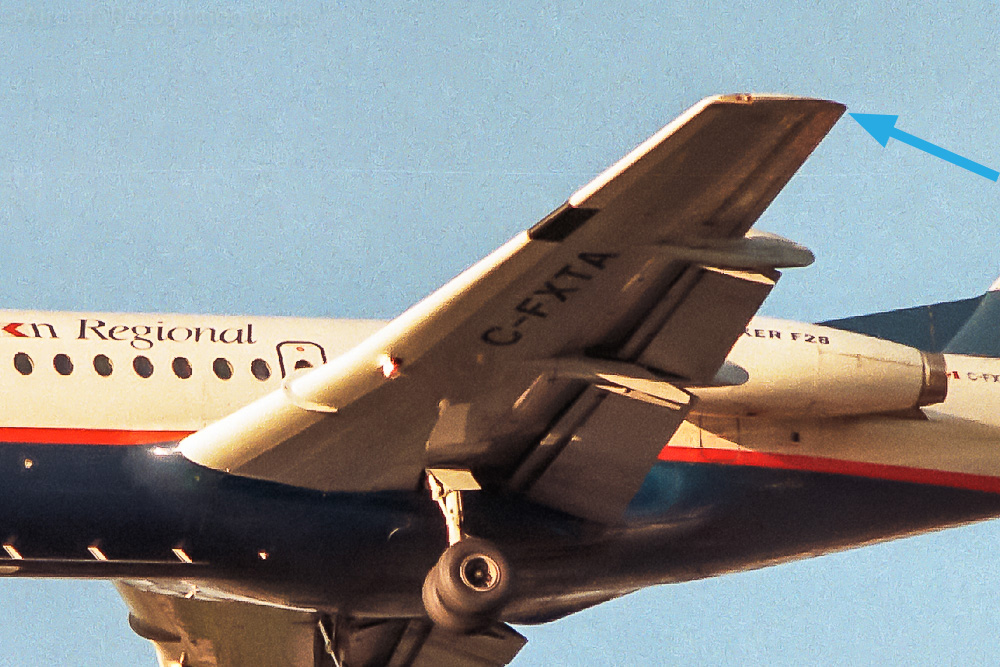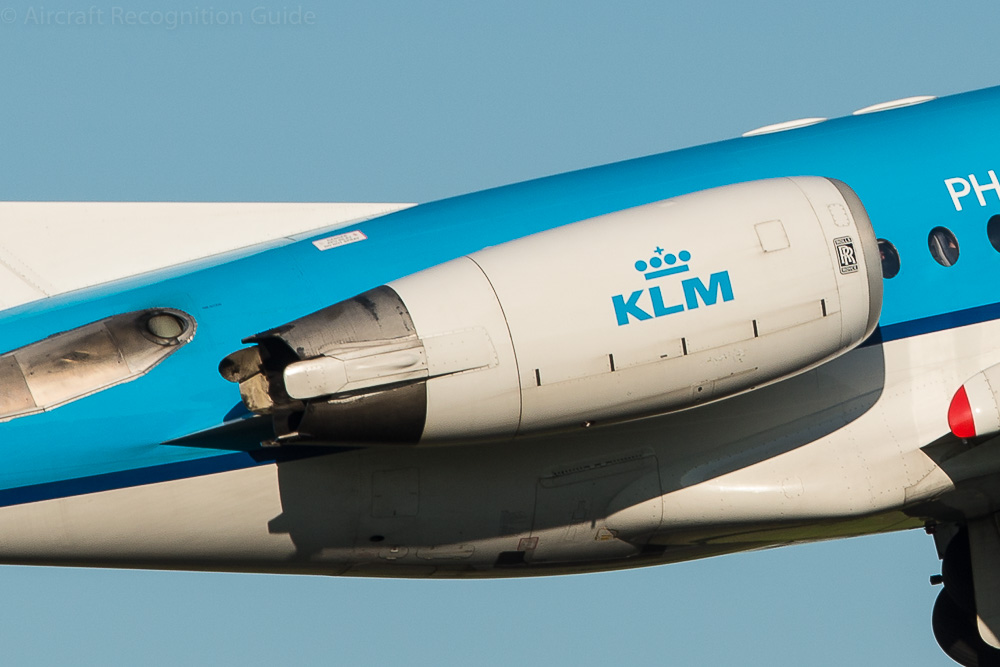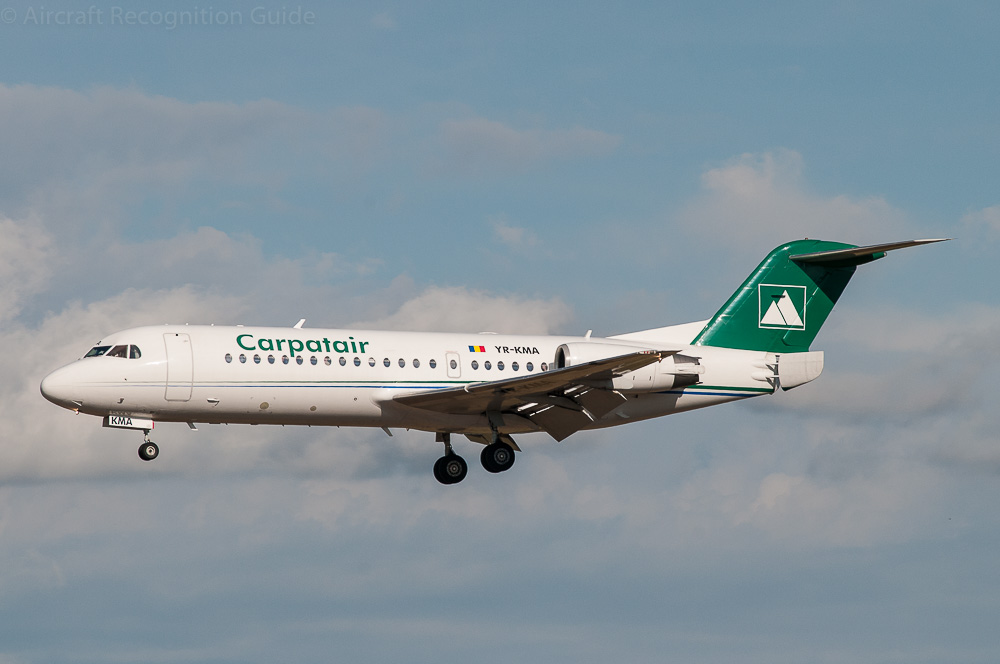
Fokker F28 Fellowship, Fokker 70 & Fokker 100
Fokker's first jet transport aircraft saw the light in the second half of the 1960s. As was modern in that time the aircraft had its jet engines attached to the rear fuselage and a T-tail to keep the jet exhaust away from the horizontal stabiliser. Unusual however, was the tailcone that could be split and opened to act as an air brake. When closed the two small streamline bodies of the hydraulic actuators are still cearly visible. The vertical stabiliser has quite a large dorsal fin and is rounded on the top. The cockpit windows are also of interest for easy identification, especially the (nearly) D-shaped last side window and the eyebrow windows (on the first generation only). Finally, the aircraft has oval cabin windows.
Visible on this nose detail are the nearly D-shaped cockpit side windows of the Fokker 70 and 100. The original F28 has an eyebrow window as well.
The large dorsal fin is one of the recognition points of the Fokker F28 family, as is the air brake in the tailcone (which is hardly used because the 70 and 100 have thrust reversers).
Different versions
The different versions of the Fokker F28 can be recognised by:
- the shape of the engine nacelles
- the presence of an eyebrow cockpit window
- the length of the fuselage
- the number of overwing emergency exits
- the presence of a cargo door
- the wing span
F28 Fellowship
The first generation F28 received the nickname Fellowship, similar to Friendship for the F27. All Fellowships have an eyebrow cockpit window on each side. Also they have slim engine nacelles without thrust reversers.
F28-1000
The first version of the F28 was the F28-1000. It is one of the short body subtypes. There is one overwing emergency exit on each side.
F28-1000C
This version is the same as the F28-1000, except for the cargo door in the left front fuselage. Depending on the paint quality this is clearly visible. In addition, where the cargo door edges cross the line of cabin windows, there are two missing compared to the standard -1000.
The cargo door is clearly visible on this F28-1000C. If not, the two absent cabin windows compared to the F28-1000 are a clue as well.
F28-2000
A fuselage stretch of somewhat more than two metres resulted in the F28-2000. Even though it is modestly longer than the F28-1000, this is still cearly visible. If in doubt count the cabin windows: 14 between the door and emergency exit versus 11 on the short body versions. This version has one emergency exit above the wings on each side.
An F28-2000 with a longer fuselage than the F28-1000, but still with one emergency exit above the wings.
F28-3000 & F-28-3000R
Compared to the F28-1000, which has the same fuselage length, the F28-3000 has a 1.5 m wider span. This means 75 cm extension of each wing tip, so hardly visible, except when you look closely from above or below the wing. Then the size of the area outside the ailerons is larger on the F28-3000 than on the F28-1000.
The F28-3000R is the same as the F28-3000, except with the weight and performance limitations of the F28-1000.
This is an F28-3000, although from this angle this is not visible that the wing tips have a 75 cm extension. For a detail photo see at F28-4000.
F28-3000C & F28-3000RC
This is the same as the F28-3000 but then with the cargo door of the F28-1000C. The F28-3000RC is the same to the F28-3000C as the F28-3000R is to the F28-3000.
This is one of the two F28-3000Cs. However, it is quite difficult to distinguish from the F28-1000C above. (photo: John Proctor/WikiMedia)
F28-4000
The F28-4000 combines the long fuselage of the F28-2000 with the wings of the F28-3000. To allow more passengers to be carried, it has two emergency exits on each side, the only Fellowship version to have these. So identification is easy.
F28-6000
The final Fellowship variant was supposed to be an F28-2000 with short field performance. To this extent, it had leading edge slats. The two aircraft built were later converted to F28-2000.
F28-6000
Fokker 70 & Fokker 100
The second generation F28 is characterised by the absence of eyebrow windows for the cockpit (see photo at the top). Furthermore, it has larger diameter engines with thrust reversers.
Rolls Royce Tay engine of a Fokker 70, with streamline bodies for the thrust reversers.
Fokker 70 (F28-0070)
The shortest of the Rolls Royce Tay powered versions is identified by the single emergency exit above the wings.
The Fokker 70 has one overwing emergency exit. Here it has the air brake in the tail cone deployed.
Fokker 100 (F28-0100)
Accommodating more than a hundred passenger the Fokker 100, officially designated F28-0100, has two overwing emergency exits. Some aircraft have an additional (larger) exit on the left side, in front of the engine.
This Fokker 100 has an emergency exit in front of the left hand engine, in addition to the two overwing exits.
Confusion possible with
Douglas DC-9
Especially the shortest versions of the DC-9 could be confused with the F28, as both have an eyebrow window. However, the DC9 has a pointed tail cone without air brake and hardly a dorsal fin.
Comac ARJ21

This Chinese regional jet looks like a small DC-9 or MD-87, so many differences compared to the F28 also apply to the ARJ21. Most obvious differences are the high bypass engines with separate fan exhausts on the ARJ21 and the tail/atil cone.
Canadair Regional Jet
The longest versions of the Canadair Regional Jet are less likely to avoid confusion with the Fokkers, given that they have only four cockpit windows, separate fan exhausts and standard winglets.
BAC One-Eleven
BAC One-Elevens have a similar basic configuration as the F28s, including oval cabin windows. The 111 has no dorsal fin though, and no eyebrow cockpit windows. Finally, it has an APU exhaust in the pointed tail cone.


